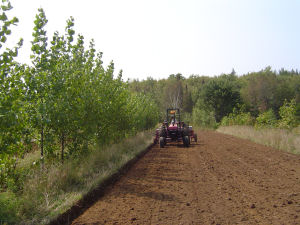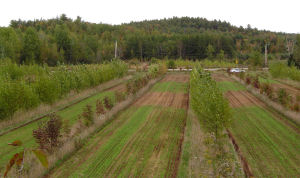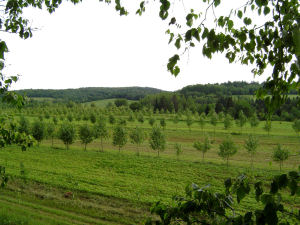Hardwood and hybrid poplar (HP) plantations have always played a marginal role on the privately owned lands of southern Quebec, where their growth potential is the highest. The lack of interest for planting hardwood and HP is due, in part, to current conflicts between the proponents of a large agricultural land base and those advocating the restoration of forest stands. Furthermore, considering the money involved in the establishment and management of such plantations, the absence of short-term investment returns for hardwood production and insufficient knowledge about HP wood production potential, most landowners do not expect any economic benefit from these plantations.
 |
The hybrid poplar-hardwood intercropping system at St. Edouard site (Quebec, Canada) in 2006 during the third season of growth, showing the winter whear sowing. (Photo courtesy of D. Rivest) |
Although they are not well known in Quebec yet, tree-based intercropping (TBI) systems could constitute an interesting way for landowners to improve the profitability of hardwood and HP plantations. TBI systems also present the benefit to conserve the agricultural possibilities of the arable lands, which is not possible with conventional plantation models. They also encourage interactions between foresters and farmers.
In 2004, Universite Laval established TBI systems on two pilot study sites (St. Paulin and St. Edouard) in the Mauricie region, in Quebec, with the support and involvement of two landowners (Le Baluchon and Les arpents verts). These sites allowed us to test and demonstrate the effects of two alley treatments (annual crop rotation vs bare soil), two different clones of HP (DN-3570 and DN-3333), four species of high-valued hardwoods (black cherry, red ash, white ash and red oak) and two alley crop managements (organic at St. Paulin vs conventional at St. Edouard) on tree growth and crop productivity. Weeds were controlled by the use of plastic mulch along the tree row. At the St. Edouard site, the alley crops were a succession of winter cereals (rye-wheat-wheat) whereas the ones at St. Paulin were oats-buckwheat-buckwheat.
 |
The hybrid poplar-hardwood intercropping system at St. Paulin site (Quebec, Canada) in 2005 during the second season of growth, showing the buckwheat flowering. (Photo courtesy of D. Rivest) |
The disposition of HP and hardwood species in alternate rows (10 or 12 m spacing, for St. Paulin and St. Edouard, respectively) should allow for two harvests of HP for every harvest of hardwood species. HP harvest should contribute to maintaining an open site, thus reducing period of high shading effects. In addition to creating a favourable environment for hardwood species establishment, the HP could generate mid-term incomes from poplar veneer. Furthermore, because of the HP's rapid growth, it is interesting to note that the landowners perceive this TBI system as being more attractive than conventional plantations or TBI systems with hardwoods only. Preliminary results from this on-farm experiment are encouraging and seem to support this perception.
| The hybrid poplar-hardwood intercropping system at St. Edouard site (Quebec, Canada) in fall 2006 during the third season of growth, showing the winter wheat emergence and the comparison of two alley treatments (annual crop rotation vs bare soil). (Photo courtesy of D. Rivest.) |  |
After the third year, the growth of HP planted in TBI systems increased by 4 to 14% in height and by 9 to 29% in diameter, as compared to the control treatment, for St. Paulin and St. Edouard, respectively. Although the HP were at an initial stage of development, these results illustrate that HP growing in TBI systems may produce a similar or higher amount of timber when compared to conventional mechanical weed control treatment.
 |
On farm trial at St. Paulin site (Quebec, Canada) in 2006 during the third season of growth. The effects of two alley treatments (annual crop rotation vs bare soil), two clones of HP and two hardwood species on tree growth and crop productivity is tested. (Photo courtesy of D. Rivest). |
Since no fertilization was used at St. Paulin, contrary to St. Edouard, the better HP response to intercrops at the St-Edouard site could be attributed to the assimilation of a portion of nitrogen coming from the alley crop fertilization and its availability through leaching. Other studies in progress regarding soil quality and HP nutrition will help to explain this observation. In spite of a high rate of tree survival (more than 95%), the growth of the hardwood species was more heterogeneous than that of HP. Hence, it appears difficult for the moment to reach any conclusion regarding the effects of alley crops on the hardwood species' performance. Compared to crop yields in open-field control plots, yields in the TBI systems were not affected by trees.
The HP-hardwood intercropping systems described here were established successfully and have already contributed greatly to our understanding of their initial stage of development. Although the landowners note an increase in labour intensity in the TBI system, they do perceive an improvement in water and soil conservation, biodiversity, economic diversification and landscape quality. They also believe that this novel system is cost-effective and technically feasible. All in all, our two pilot study sites present a good technological showcase in a sustainable rural development context. The participants of the 10th North American Agroforestry Conference will have the opportunity to visit these sites during the post-conference tour as well as to speak with the researchers and landowners that contributed to this project.
By David Rivest1, Alain Cogliastro2, and Alain Olivier1
1 Departement de phytologie, Universite Laval, Quebec, Canada
2 Institut de recherche en biologie vegetale, Montreal, Canada


